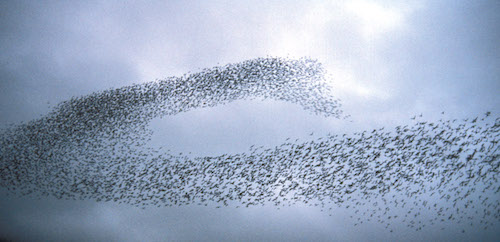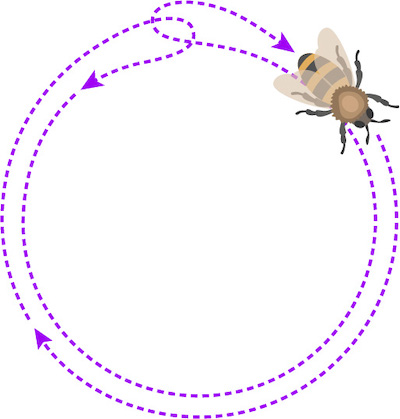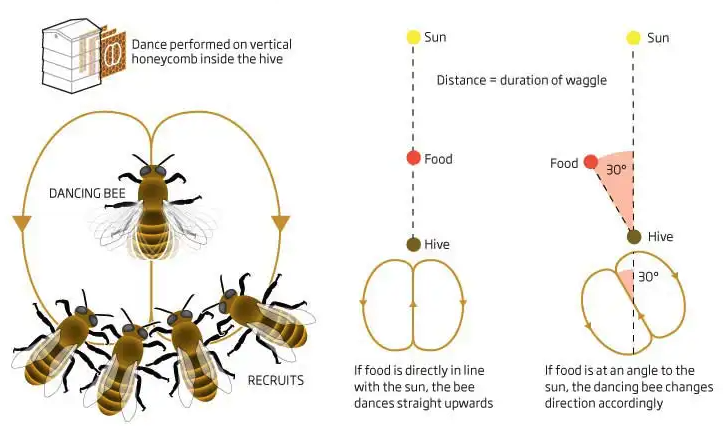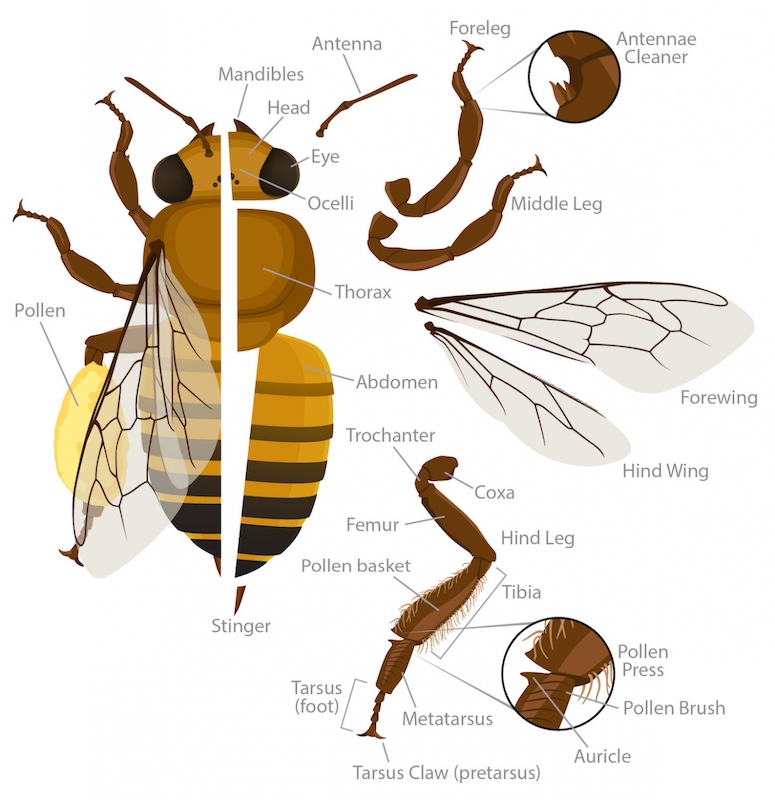🔮 Bee Behaviour
Swarming, Supersedure, Hive Maintenance, Communication in Bees and Bee Morphology
Which of the following statement is correct realted to honeybees?
Swarming

- Swarming is a natural method of colony multiplication in which a part of the colony migrates to a new site to make a new colony.
- The first swarm that comes out of the colony with old queen is called primary swarm.
- When 2-3 queen cells are constructed, after the exit of old queen (primary swarm), the next emerging new queen leaves the colony along with a group of workers called after swarm cast.
- Swarming occurs when a colony builds up a considerable strength or when the queen’s substance secreted by queen falls below a certain level.
- Swarming is a potent instinct in bees for dispersal and perpetuation of the species.
👉🏻 Steps involving in swarming:
- Strong colonies develop the instinct of swarming.
- Development of drone brood and emergence of large number of drones is first sing of swarming.
- New queen cells are built at the bottom of comb.
- When the queen cells are sealed after pupation the old queen along with 1/3rd or half colony strength moves out of the hive.
- They first settle in a nearby bush and hang in a perdant cluster.
- The scout bees go in search of appropriate place for colonization and later the entire colony moves to the suitable site.
- The first swarm which comes of the parent colony with the old queen is called primary swarm.
- The new queen which emerges kills all other stages of queen present inside the queen cell.
- Sometimes the new queen is not allowed to destroy stages of other queens.
- In this case the new queen leaves the hive along with a group of workers. This is called after swarm or cast.
Supersedure
- When an old queen is unable to lay sufficient eggs, she will be replaced or superseded by supersedure queen.
- Or when she runs out of spermathezoa in her spermatheca, and lays many unfertilized eggs from which only drones emerge. In this case, one or 2 queen cells are constructed in the
middle of the comband not at the bottom. - At a given time both new and old queens are seen simultaneously.
- Later the old queen disappears.
Absconding
- Abandoning of bees or leaving permanently from the colony is called absconding.
- In other words absconding is the term used when a colony of honey bees leaves its home in search of another.
- It is not the same as swarming.
- When a colony absconds, it means that all the bees in the colony leave together to find a new home.
- This happens when the conditions in their current hive become too difficult or too stressful for the bees.
Foraging
- The collection of pollen and nectar by honey bees is called foraging.
- Foraging range of Apis mellifera is 3 km.
Emergency Queen
- On sudden death of a queen, eggs of workers are converted to a queen by rearing the larva in extended cells and feeding them with royal jelly.
Colony odour
- Every colony has a specific odour.
- This is brought about by scent fanning of secretion of vasanov gland present in last abdominal segment of worker bees recognise colony odour and return to same hives.
Hive Maintenance
- Hive temperature maintenance:
- Brought about by fanning of wings in hot weather to reduce temperature.
- In cold weather they sit on the brood and prevent heat loss.
- Division of labour: Each and every caste of bees have their own role to play as described in previous chapters.
- Queen controls colony with her queen’s substance: Guarding the hive: The workers perform this duty by sitting at hive entrance and preventing and stinging intrudes.
- Royal fidelity or Blossom faithfulness: Bees restrict themselves to a single source of pollen and hectar until it is available. Only if the pollen and nectar from a plant species is exhausted they move to the next plant species.
Communication in Bees
- Bees communicate using various phenomones, including the queen’s substance, vasanov gland secretion, alarm pheromone emitted from sting and secretion of tarsal gland.
- In addition the bees also communicate by performing certain dances.
- When scout bees return to the box after foraging they communicate to the other forages present in the box about the direction and distance of the food source from the hive by performing dances.
Karl von Frischwon Nobel prize (1973) for his work on Dance language and Orientation of Bees (1967).- The important types of dances:
1. Round dance

- Round dance is used to indicate a
short distance(Less than 50 m in case of A. mellifera). - The bee runs in circles, first in one direction and then in opposite direction, (clockwise and anticlockwise).
2. Waggle Dance


- This is used to indicate
long distance(more than 50 m in case of A. mellifera). - Here the bee makes two half circles in opposite directions with a straight run in between.
- During the straight run, the bee shakes (wags) its abdomen from side to side, the number of wags per unit time inversely proportional to the distance of the food (more the wags, less the distance).
- The direction of food source is conveyed by the angle that the dancing bee makes between its straight run and top of the hive which is the same as between the direction of the food and direction of the sun.
- The bees, can know the position of the sun even if it is cloudy
- Wag tail dance to communicate the direction and distance of food source.
- Also known as Tail wagging dance or Wag-tail dance.
Explore More 🔭
🟢 https://youtu.be/pb1lRI-YePU
🟢 https://youtu.be/wcIKJu3Sjmc
🟢 https://youtu.be/PRGc7skekMQ
Morphology

- The hind legs of a worker bee contain a pollen basket — a collection of hairs where pollen is stored for transport.
- The stinger is only found in female honey bees. A worker bee’s barbed stinger is used for defense. A queen bee’s smooth stinger is used for eliminating rival queens.
- The honey sac is an internal, stomach-like organ where nectar is stored.
- Wax glands are located on the underside of the worker bee’s abdomen. The glands form and excrete wax.
- Crop is converted to honey stomach in honey bees.
- The three pair of legs of worker honey bee are modifies for:
- Antennal cleaning
- Wax picking
- Pollen collection
- The antenna cleaning structures are found on basitarsus (notch) and tibia (spur) in foreleg of honey bees.
- Tibia of middle leg bears a short (wax pick) used in removing wax plates and scrapping pollen basket of hind legs.
- The third pair of leg of honey bee is modified for pollen collection. Tibia has long curved hairs which forms the pollen brush or scopa.
- The space between the curved hairs and tibia is corbicula or pollen basket.
- The basitarsus is also flat and has ten rows of stiff spines which help in pollen collection.
- The visible range of bees see is from 300-600 nm. The colours bees see are blue green, blue violet, ultra violet called Bee’s purple.
Explore More 🔭
🟢 https://youtu.be/QEzlsjAqADA
🟢 https://youtu.be/npn-yhGJw_c
References
- https://nbb.gov.in/
- https://en.wikipedia.org/wiki/Bee
- The Insects - Structure and Function (4th Edition, 1998) – R.F. Chapman. Cambridge University Press
- https://en.wikipedia.org/wiki/Apiary
- https://agritech.tnau.ac.in/farm_enterprises/fe_api_typesofhoneybee.html
Which of the following statement is correct realted to honeybees?
Swarming

- Swarming is a natural method of colony multiplication in which a part of the colony migrates to a new site to make a new colony.
- The first swarm that comes out of the colony with old queen is called primary swarm.
- When 2-3 queen cells are constructed, after the exit of old queen (primary swarm), the next emerging new queen leaves the colony along with a group of workers called after swarm cast.
- Swarming occurs when a colony builds up a considerable strength or when the queen’s substance secreted by queen falls below a certain level.
- Swarming is a potent instinct in bees for dispersal and perpetuation of the species.
👉🏻 Steps involving in swarming:
- Strong colonies develop the instinct of swarming. …
Become Successful With AgriDots
Learn the essential skills for getting a seat in the Exam with
🦄 You are a pro member!
Only use this page if purchasing a gift or enterprise account
Plan
Rs
- Unlimited access to PRO courses
- Quizzes with hand-picked meme prizes
- Invite to private Discord chat
- Free Sticker emailed
Lifetime
Rs
1,499
once
- All PRO-tier benefits
- Single payment, lifetime access
- 4,200 bonus xp points
- Next Level
T-shirt shipped worldwide

Yo! You just found a 20% discount using 👉 EASTEREGG

High-quality fitted cotton shirt produced by Next Level Apparel